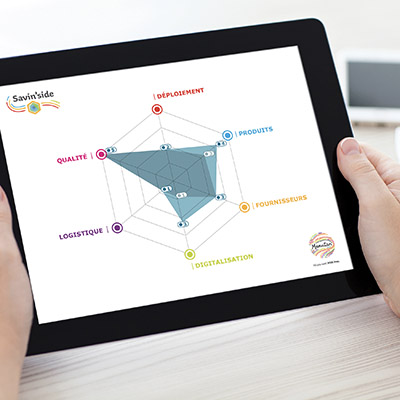In an uncertain and volatile world where the number of variables keeps increasing, incorporating a predictive dimension into company decision-making systems is essential. This is where predictive analysis comes in – a data-driven method that aims to predict future outcomes. Behind predictive analysis, we find data mining techniques, machine learning derived from artificial intelligence (AI), and a whole array of statistical models. Today, these technologies are becoming more accessible to the masses and are even making their way into procurement departments.
What is predictive analysis?
There are commonly three types of data analytics with different technical implications and purposes:
- Descriptive analysis is a technique that describes and analyses past events (this is what Business Intelligence software offers, for example);
- Predictive analysis helps evaluate the probability that the same results will repeat[NE1] ;
- Prescriptive analysis identifies a phenomenon and suggests actions to implement in response.
Using predictive analysis thus serves to identify future trends in datasets. In other words, it involves extrapolating information from current and historical data to predict the outcome and enable companies to improve their decision-making processes. In this configuration, anticipation is the key word.
This tool is widely favoured by businesses. This is particularly true in sectors such as health care, energy, financial services, and insurance, where it helps to identify predictive models, anticipate behaviours, or detect potential risks. For example, in establishing a car insurance contract, predictive analysis can anticipate a driver’s potential risks by considering several predictive factors (age, driving experience, etc.), helping the insurer determine an appropriate insurance premium for each customer.
Ultimately, this gives any company a head start in its market. It helps reduce risks, improve decision-making, and gain operational efficiency. The end result translates into a genuine competitive advantage.
How does predictive analysis work?
It all starts with defining a problem. You must then identify the right data flows to address it, then collect, organise, and process this data. In terms of technology, predictive analysis relies on data mining to prepare and examine large datasets (particularly Big Data) from various angles.
Then comes the time to develop predictive models, based on the problem to be solved and the nature of the dataset. The data scientist must apply the most relevant tool to obtain the desired results. Predictive analysis largely relies on Machine Learning techniques to create predictive models that process unstructured datasets with advanced speed and precision. Machine Learning is a branch of artificial intelligence (AI), at the heart of data science. Among the most commonly used predictive models are linear regression models, logistic regression, decision trees, and neural networks.
Lastly, it’s a continuous process. This is why it’s important to verify the model’s accuracy and adjust it accordingly. To do this, predictions are compared with actual data over a period of time. We can rely on indicators such as the error percentage to evaluate the model’s performance.
Predictive analysis applied to procurement
Due to their position at the heart of the company’s ecosystem, procurement departments have access to a wealth of data. Properly exploited, this "black gold" holds tremendous opportunities for managing activity and building procurement strategies. The idea is no longer to react to events but also to understand and anticipate them. It’s worth noting that this information is not an end in itself but rather a means of optimising rapid decision-making.
Although such application is not yet widespread, observers note a certain interest from the procurement community. In the latest survey conducted by Deloitte, more than a third of procurement decision makers believe that predictive analysis is among the most useful resources in their field.
This feeble adoption of predictive analysis by procurement departments is primarily explained by its complex implementation. First, you need to have a spend analytics system. Before anticipating anything, you need to know which products are consumed, by whom, and from which supplier, at a given time. Then, you need to integrate all other relevant data from various information sources (hence the use of data mining). For now, predictive analysis is a larger-scale project in the company, whose human and technical resources are put at the service of several departments (sales, marketing, finance, procurement...).
The benefits of predictive analysis for procurement
Predictive patterns and models can be used in multiple ways by procurement departments. In procurement, the first field of action for predictive analysis lies in efficient stock management. By analysing supplier orders, customer demands, or sales, we can devise statistical and algorithmic models to forecast company purchasing volumes. This analytics helps businesses anticipate supply needs, optimise stocks, and improve planning. The result is less overstocking and fewer stockouts while optimising costs.
Buyers can transpose this dynamic and predictive vision to other practical applications:
- Managing supplier relationships;
- Supplier performance management;
- Price fluctuations;
- Market developments;
- Managing and anticipating potential risks;
- Seizing new procurement opportunities;
- Predicting expenditure…
As a result, they gain in responsiveness and efficiency to contribute to procurement strategy. They can thus secure their supply chain, reduce costs, and strengthen their supplier partnerships with increased effectiveness. This allows them to continue to reinforce their strategic positioning within the company.
Beyond predictive analysis, it’s easy to imagine the advantages that prescriptive analysis presents through its recommendations. Patrick Chabannes, who was at the time Senior Solution Strategist at Determine, a SaaS/Cloud editor of software solutions for contract management, supplier management, strategic sourcing and Procure-to-Pay, shares a concrete example: "Procurement IS will be able to push recommendations to users taking into account personal business rules by creating interactive situations. Imagine a direct production buyer following their two qualified suppliers in series mode. And a recommendation drops indicating that a competitor of these two suppliers has increased their turnover by 17% while their two suppliers are at 1 and 3% respectively. The buyer then asks the right questions: What happened? What did they find? What are my own competitors benefiting from by working with these sources?"
As you can see, predictive analysis allows procurement departments to anticipate, accelerate, and secure their decisions. It therefore represents a tremendous lever for creating value for the function, the company, and stakeholders.
However, to be able to start on the path that leads to such possibilities, it is essential to ensure data availability. To do this, procurement departments must get ready and generate maximum data to be able to analyse it. The first step is to digitalise the entire Procure-to-Pay process.









